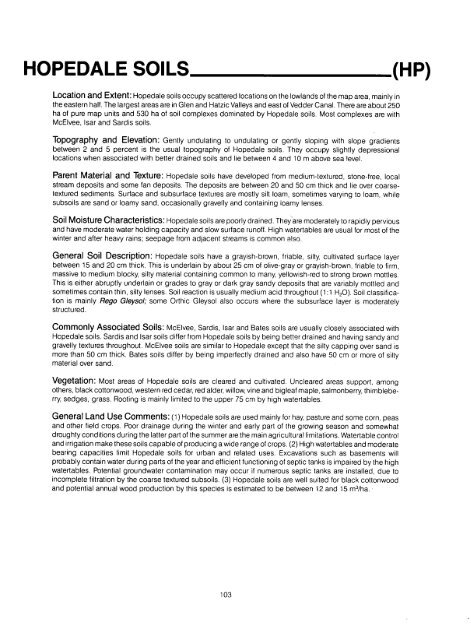Soils of the - Agriculture and Agri-Food Canada
Soils of the - Agriculture and Agri-Food Canada
Soils of the - Agriculture and Agri-Food Canada
You also want an ePaper? Increase the reach of your titles
YUMPU automatically turns print PDFs into web optimized ePapers that Google loves.
HOPEDALE SOILS (HP)<br />
Location <strong>and</strong> Extent : Hopedale soils occupy scattered locations on <strong>the</strong> lowl<strong>and</strong>s <strong>of</strong> <strong>the</strong> map area, mainly i n<br />
<strong>the</strong> eastern half. The largest areas are in Glen <strong>and</strong> Hatzic Valleys <strong>and</strong> east <strong>of</strong> Vedder Canal . There are about 250<br />
ha <strong>of</strong> pure map units <strong>and</strong> 530 ha <strong>of</strong> soil complexes dominated by Hopedale soils . Most complexes are wit h<br />
McElvee, Isar <strong>and</strong> Sardis soils .<br />
Topography <strong>and</strong> Elevation : Gently undulating to undulating or gently sloping with slope gradient s<br />
between 2 <strong>and</strong> 5 percent is <strong>the</strong> usual topography <strong>of</strong> Hopedale soils . They occupy slightly depressiona l<br />
locations when associated with better drained soils <strong>and</strong> lie between 4 <strong>and</strong> 10 m above sea level .<br />
Parent Material <strong>and</strong> Texture : Hopedale soils have developed from medium-textured, stone-free, loca l<br />
stream deposits <strong>and</strong> some fan deposits . The deposits are between 20 <strong>and</strong> 50 cm thick <strong>and</strong> lie over coarse -<br />
textured sediments . Surface <strong>and</strong> subsurface textures are mostly silt loam, sometimes varying to loam, whil e<br />
subsoils are s<strong>and</strong> or loamy s<strong>and</strong>, occasionally gravelly <strong>and</strong> containing loamy lenses .<br />
Soil Moisture Characteristics : Hopedale soils are poorly drained . They are moderately to rapidly perviou s<br />
<strong>and</strong> have moderate water holding capacity <strong>and</strong> slow surface run<strong>of</strong>f. High watertables are usual for most <strong>of</strong> <strong>the</strong><br />
winter <strong>and</strong> after heavy rains ; seepage from adjacent streams is common also .<br />
General Soil Description : Hopedale soils have a grayish-brown, friable, silty, cultivated surface laye r<br />
between 15 <strong>and</strong> 20 cm thick . This is underlain by about 25 cm <strong>of</strong> olive-gray or grayish-brown, friable to firm ,<br />
massive to medium blocky, silty material containing common to many, yellowish-red to strong brown mottles .<br />
This is ei<strong>the</strong>r abruptly underlain or grades to gray or dark gray s<strong>and</strong>y deposits that are variably mottled an d<br />
sometimes contain thin, silty lenses . Soil reaction is usually medium acid throughout (1 :1 H 2 O) . Soil classification<br />
is mainly Rego Gleysol; some Orthic Gleysol also occurs where <strong>the</strong> subsurface layer is moderatel y<br />
structured .<br />
Commonly Associated <strong>Soils</strong> : McElvee, Sardis, Isar <strong>and</strong> Bates soils are usually closely associated wit h<br />
Hopedale soils . Sardis <strong>and</strong> Isar soils differ from Hopedale soils by being better drained <strong>and</strong> having s<strong>and</strong>y an d<br />
gravelly textures throughout . McElvee soils are similar to Hopedale except that <strong>the</strong> silty capping over s<strong>and</strong> i s<br />
more than 50 cm thick . Bates soils differ by being imperfectly drained <strong>and</strong> also have 50 cm or more <strong>of</strong> silty<br />
material over s<strong>and</strong> .<br />
Vegetation : Most areas <strong>of</strong> Hopedale soils are cleared <strong>and</strong> cultivated . Uncleared areas support, amon g<br />
o<strong>the</strong>rs, black cottonwood, western red cedar, red alder, willow, vine <strong>and</strong> bigleaf maple, salmonberry, thimblebe -<br />
rry, sedges, grass . Rooting is mainly limited to <strong>the</strong> upper 75 cm by high watertables .<br />
General L<strong>and</strong> Use Comments : (1) Hopedale soils are used mainly for hay, pasture <strong>and</strong> some corn, pea s<br />
<strong>and</strong> o<strong>the</strong>r field crops . Poor drainage during <strong>the</strong> winter <strong>and</strong> early part <strong>of</strong> <strong>the</strong> growing season <strong>and</strong> somewha t<br />
droughty conditions during <strong>the</strong> latter part <strong>of</strong> <strong>the</strong> summer are <strong>the</strong> main agricultural limitations . Watertable contro l<br />
<strong>and</strong> irrigation make <strong>the</strong>se soils capable <strong>of</strong> producing a wide range <strong>of</strong> crops . (2) High watertables <strong>and</strong> moderat e<br />
bearing capacities limit Hopedale soils for urban <strong>and</strong> related uses . Excavations such as basements wil l<br />
probably contain water during parts <strong>of</strong> <strong>the</strong> year <strong>and</strong> efficient functioning <strong>of</strong> septic tanks is impaired by <strong>the</strong> hig h<br />
watertables . Potential groundwater contamination may occur if numerous septic tanks are installed, due t o<br />
incomplete filtration by <strong>the</strong> coarse textured subsoils . (3) Hopedale soils are well suited for black cottonwoo d<br />
<strong>and</strong> potential annual wood production by this species is estimated to be between 12 <strong>and</strong> 15 m3/ha .<br />
103

















